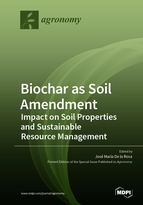Biochar as Soil Amendment: Impact on Soil Properties and Sustainable Resource Management
A special issue of Agronomy (ISSN 2073-4395). This special issue belongs to the section "Soil and Plant Nutrition".
Deadline for manuscript submissions: closed (15 September 2019) | Viewed by 86507
Special Issue Editor
Interests: climate and environment; carbon sequestration; soil quality; soil organic matter; soil amendments; biochar; analytical and applied pyrolysis
Special Issues, Collections and Topics in MDPI journals
Special Issue Information
Dear Colleagues,
There is an imperative necessity of sustainable management for the increasing quantity of organic waste. In this sense, pyrolysis or carbonization (the thermal decomposition of biomass under low or no oxygen supply) offers a promising approach for managing carbon-rich wastes, such as sewage sludge, pulp and paper industry residues, or crop residues, and to create added value coproducts, such as biochar.
The benefits of biochar as a soil ameliorant have been profusely studied, but the knowledge concerning its effects on soil properties and composition is still limited. Furthermore, the role of pyrolysis products within the concept of circular economy still has to be assessed. This need for information is increased by the great variability of composition and properties of the produced biochars and their dependence on pyrolysis conditions, feedstock nature, and additives.
This Special Issue pursues to motivate discussion on this issue by bringing together scientists from the diverse fields of soil, applied pyrolysis, resources management, agronomy, and carbon dynamics.
Dr. José María de la Rosa
Guest Editor
Manuscript Submission Information
Manuscripts should be submitted online at www.mdpi.com by registering and logging in to this website. Once you are registered, click here to go to the submission form. Manuscripts can be submitted until the deadline. All submissions that pass pre-check are peer-reviewed. Accepted papers will be published continuously in the journal (as soon as accepted) and will be listed together on the special issue website. Research articles, review articles as well as short communications are invited. For planned papers, a title and short abstract (about 100 words) can be sent to the Editorial Office for announcement on this website.
Submitted manuscripts should not have been published previously, nor be under consideration for publication elsewhere (except conference proceedings papers). All manuscripts are thoroughly refereed through a single-blind peer-review process. A guide for authors and other relevant information for submission of manuscripts is available on the Instructions for Authors page. Agronomy is an international peer-reviewed open access monthly journal published by MDPI.
Please visit the Instructions for Authors page before submitting a manuscript. The Article Processing Charge (APC) for publication in this open access journal is 2600 CHF (Swiss Francs). Submitted papers should be well formatted and use good English. Authors may use MDPI's English editing service prior to publication or during author revisions.
Keywords
- Production and analytical characterization of biochar and pyrogenic organic matter
- Soil properties
- Soil amendment
- Sustainable agriculture
- Resource management






